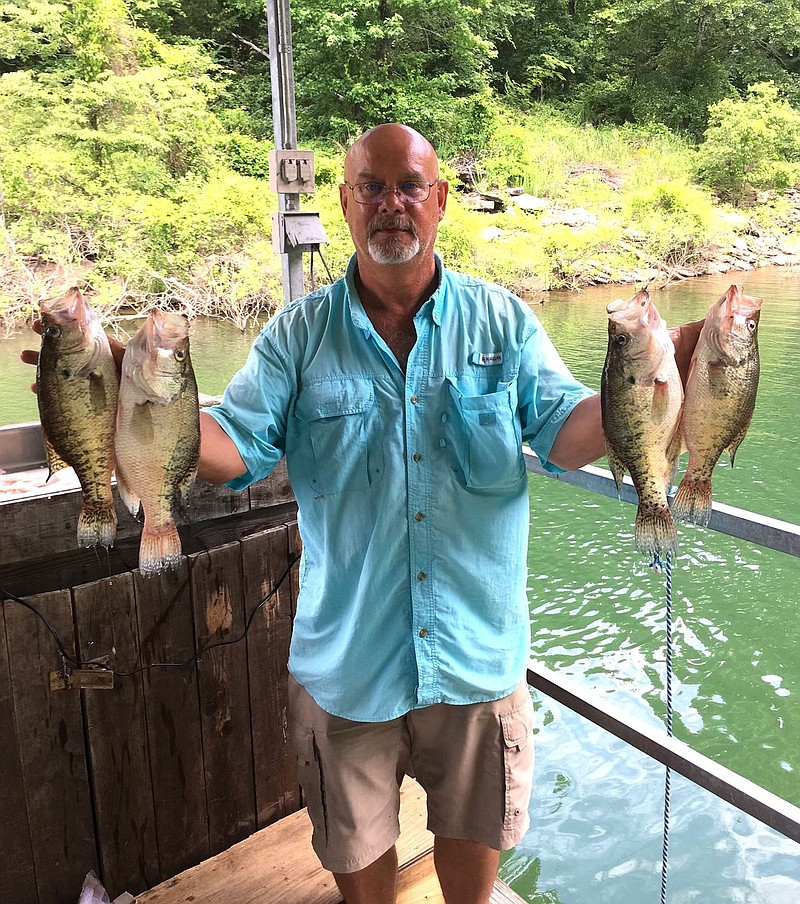Summer is a challenging time to catch crappie, prompting some anglers to adopt unconventional techniques.
Wayne Stewart, owner of Catchin' Crappie Guide Service, specializes in trolling deep-diving crankbaits over open water at Greers Ferry Lake. The technique is very popular in old reservoirs in Mississippi, like Sardis Lake, which don't have much cover. Greers Ferry was flooded with its timber still intact, creating plenty of deep structure to hold crappie in hot weather. The lake also contains countless brushpiles sunk by anglers and the Arkansas Game and Fish Commission.
Standing timber and brushpiles make it challenging for trolling because they snag the big 300 series crankbaits that Stewart uses, at a cost of about $6 to $9 a pop.
"I lose over a hundred crankbaits a year," Stewart said. "The companies know I'm a guide, so they give me a little bit of a break, but not much."
When a crankbait snags in wood, Stewart does what he can to free it. If the bill is wedged in wood, it usually releases easily. If the hook is snagged, it's usually a goner.
"I don't spend too much time messing with it," Stewart said. "My clients are paying me to fish, not to waste a bunch of time freeing lures."
Fishing primarily above The Narrows, Stewart trolls at least 10-12 rods of different lengths. Each side has four, and there's often a ninth and even 10th rod on the stern. The rod nearest the bow is an 181/2-foot crappie rod made by B&M. The rods get shorter as you move astern. This keeps the crankbaits separated without having to use side planers and downriggers.
"You want to keep them apart so that you don't get a great big, tangled mess," Stewart said.
For crappie, Stewart likes crankbaits with aggressive colors. Pink is one of the most productive.
"Nothing that crappie eat in the lake is pink, but they hit pink crankbaits like crazy," Stewart said. "I don't know why. All I know is that it works."
Stewart uses an electric motor to troll about 2-3 miles per hour. When a crappie is hooked, the speed prevents it from swimming out to the sides and fouling the other lines.
"They just drag along behind," Stewart said. "Sometimes they come up to the surface and get pulled along."
The style of fishing is relaxed, casual and social. Stewart said he and his clients chat and enjoy snacks and drinks while waiting for a crappie to strike. Sometimes they get multiple strikes, and that's when it can get a little frantic.
Unlike crappie anglers who target big fish in brushpiles using Garmin Panoptics LiveScope technology, Stewart's approach is fairly low-tech. He said he uses LiveScope to find concentrations of baitfish. Crappie follow baitfish in open water, and Stewart uses his graph to stay with them.
A key, Stewart said, is to keep the lure at or above the depth where the crappie are. Crappie rise to strike a bait, but they won't dive after a lure that's under them.
Depth management is a science, Stewart said. Charts are available that show how deep a certain lure will run with a given amount of specific test-strength line. Stewart uses reels with line counters so that he always knows how much line is out, and that allows him to govern his lure's running depth. He said he can make them run as deep as about 18 feet.
For more information about this style of fishing, visit catchincrappie.com or contact Stewart at (870) 307-2572.

